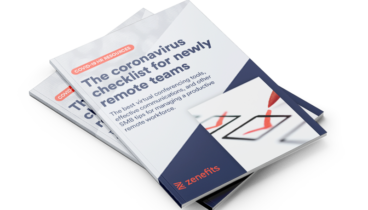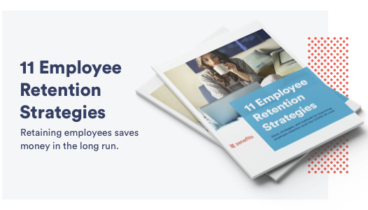How should HR staff and business owners continue to respond to COVID-19, and better prepare for the future?

Here's what you need to know:
-
HR team members and business owners should work with staff to develop flex/remote/compressed work policies that meet economic, business, and personal needs
-
Employers should have a policy that states employees should stay home when sick; employers must also foster an environment that supports the policy
-
Policies that outline how we keep the workplace sanitary and safe for workers and customers should be created to provide guidance on the best way to keep illness at bay
-
A good look at the risk factors in your industry, and a policy to deal with them, will be necessary to prepare for whatever comes your way
-
New policies that help employees and businesses address the need to care for children, and others in the household who need assistance, should be a priority
-
Healthcare coverage is a strong recruitment and retention tool that can help you attract and keep the best talent available in your area — and it shows you consider employee health a necessity
As the COVID-19 pandemic continues to shift the way we work, companies and HR policies will need to change as well. The virus has threatened the wellbeing of workers and business alike: adaptability may be the only way to weather the coronavirus storm and beyond.
Businesses and staff members are adjusting to the pressures and constraints they face. At the same time, there will need to be a shift in overall policies. For many business owners, new rules, protocols, and procedures are being developed as needed and often on the fly. But a longer look at how we do business may be in order — one that will serve business and workers long after the pandemic has cleared.
Flex work
Many companies were thrust into the remote work model when the pandemic hit; many have found it’s working well for them. For organizations that have the capacity to allow workers to perform their duties from anywhere (and sometimes at any time), the opportunity to work remotely may have been serendipity. Employees love the ability to ditch the commute and work from home — with or without shoes. Businesses are finding operating costs go down when they’re not continuously stocking the break room with snacks and paying high utility bills.
A fully remote work model is doable for some, but flex work can take many forms. Scheduling adaptations have been made to limit the amount of workers on premises at a given time, which may have been helpful to staff members who have to adjust to childcare pressures. Compressed workweeks, with more hours on fewer days, are a favorite among staffers and have also risen. Working together to find creative solutions has become a key element in keeping businesses moving forward while also managing employee needs.
HR team members and business owners should work with staff members to develop flex/remote/compressed work policies that meet economic, business, and personal needs.
HR team members and business owners should work with staff members to develop flex/remote/compressed work policies that meet economic, business, and personal needs. You may need to create some on a moment’s notice. But here are some smart, proactive steps:
- Plan ahead
- Develop a policy that allows staffers to request flexible work options
- Make and fulfill promises to discuss and create solutions
It not only translates you’re ready for anything the marketplace sends your way, you’re ready to work with staff members to find solutions that keep them working.
Read more: Why Flexible Work Arrangements Are Key for Reopening
Sick leave/leave of absence
For many small businesses, sick leave was a luxury they simply could not afford. While all business owners would love to provide generous sick time to staff members, the smallest of businesses — the ones that run lean — had difficulty justifying the expense. COVID has shifted thinking: Sick employees must stay home, for their own protection and to protect coworkers and customers.
The pandemic has created sick leave and caregiver leave policies that directly address those who have or care for those who have COVID-19. While many small businesses struggle to meet federal and local mandates, the long-term benefits outweigh short-term pressure. For some essential businesses and workers, the pressure is great — they’re working diligently to meet demand with fewer employees. For lean businesses struggling to stay afloat with economic downturns and limits, the impact of a single missing employee is significant. But they persevere.
A policy that outlines employees should stay home when sick is a start, but employers must foster an environment that supports the policy.
A policy that outlines employees should stay home when sick is a start, but employers must foster an environment that supports the policy. When staffers are afraid to take sick time, the purpose is defeated. The imperative to attend to illness and recover fully before returning to work should be a lesson well learned for business and staffers.
Read more: Everything You Need to Know About Employee Leave of Absence
Facilities management
You may never have had occasion to have the Occupational Safety and Health Administration (OSHA) visit your premises, but a new focus on workplace safety is another result of the pandemic. The way we avoid spreading germs in the workplace is a new topic that should have been discussed all along. Preparing your company for employees to return to work was only the beginning. Policies that outline how we keep the workplace sanitary and safe for workers and customers should be created to provide guidance — moving forward — on the best way to keep illness at bay.
Crisis management
You may have been thrust into the world of crisis management to respond to COVID-19, but being ready for the next threat should be outlined in a comprehensive policy. Natural disasters, economic stresses, and other issues could be coming your way. The best way to survive them is to be ready for them. A good look at the risk factors in your industry, and a policy to deal with them, will be necessary to prepare for whatever comes your way.
Read more: 4 Steps to Creating a Crisis Management Plan
Child care policies
New policies that help employees and businesses address the need to care for children, and others in the household who need assistance, should be a priority.
For many companies, the pandemic has put childcare to the frontline of discussions with staff members on scheduling and availability. School and daycare closures have created a domino effect of keeping willing workers at home. You may not have the option to create a daycare center at your organization, but there are other ways to help. Some organizations work with care centers in their area to offer discounted services for workers who can drop off and pick up children near the workplace. Others are creating more flexibility for work-from-home staffers who have children in the household. New policies that help employees and businesses address the need to care for children, and others in the household who need assistance, should be a priority.
Read more: Why Workplace Daycare Is Growing in Popularity
Healthcare benefits
The importance of offering at least the minimal healthcare coverage for employees has never been more pronounced than during this global crisis. For small businesses, the trade-off may have seemed too costly in the past, but maintaining operations and keeping a healthy workforce has shifted the balance. Healthcare coverage is a strong recruitment and retention tool that can help businesses attract and keep the best talent available in their area. When times are tough you need the best possible workers to maintain your business: that can mean providing the best possible benefits options to workers.
Businesses who have never considered providing healthcare coverage in the past now realize employee health is not only a priority, it’s a necessity.
For many small and medium-sized businesses, the perception of the cost of healthcare coverage is higher than the actual price tag. There are multiple tax incentives and benefits for businesses that provide coverage for staff. There are Affordable Care Act options and exchanges available for those who aren’t confident they can negotiate or administer policies on their own. Third-party providers may be the best option for SMBs, to find the best coverage for their team at the best price point and then administer benefits and enrollment hands-free.
Businesses who have never considered providing healthcare coverage in the past now realize employee health is not only a priority, it’s a necessity. A policy that outlines what the organization can provide moving forward isn’t just a best practice for businesses, it may be a must-have to survive COVID-19 and beyond. Look to the experts to help craft a policy and plan that works for your business and staff members today and moving forward.
Lessons to remember
When the pandemic becomes a memory in the future, it will be important for businesses to remember lessons learned. A company’s response to the needs of the organization, workers, and customers may have been key to surviving the virus. Moving forward it will be important to change policies and the way we work to be ready for whatever the economy throws our way.





